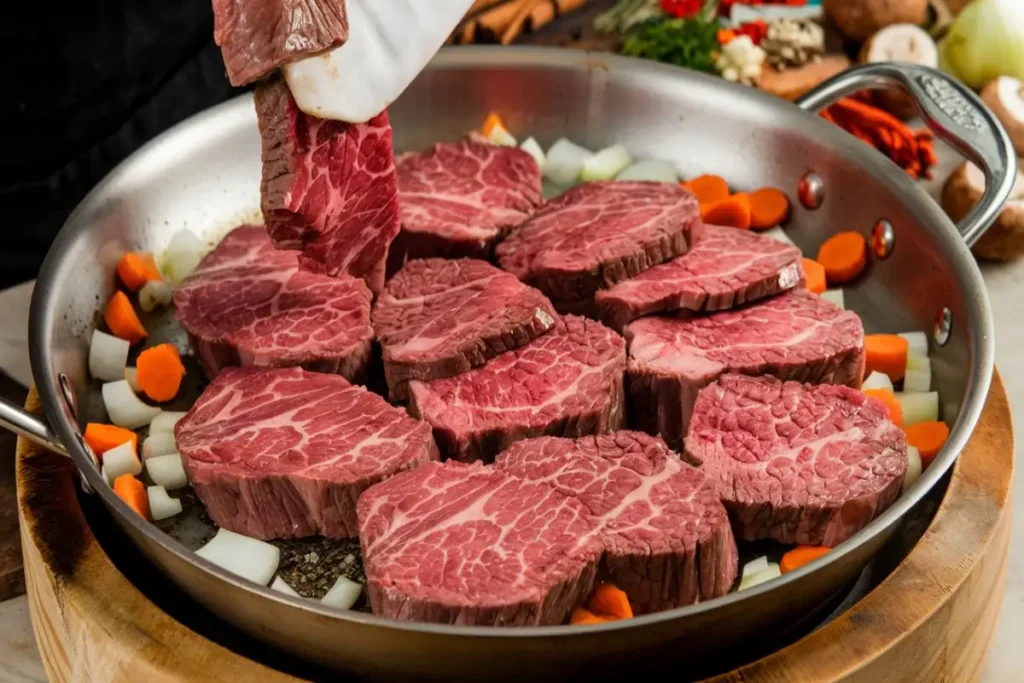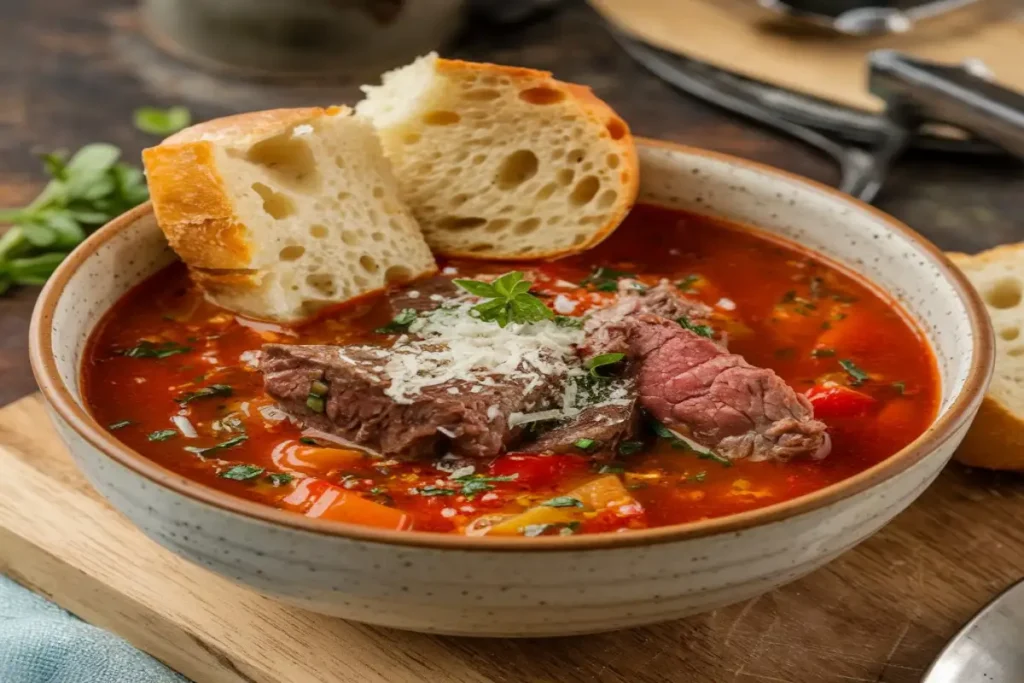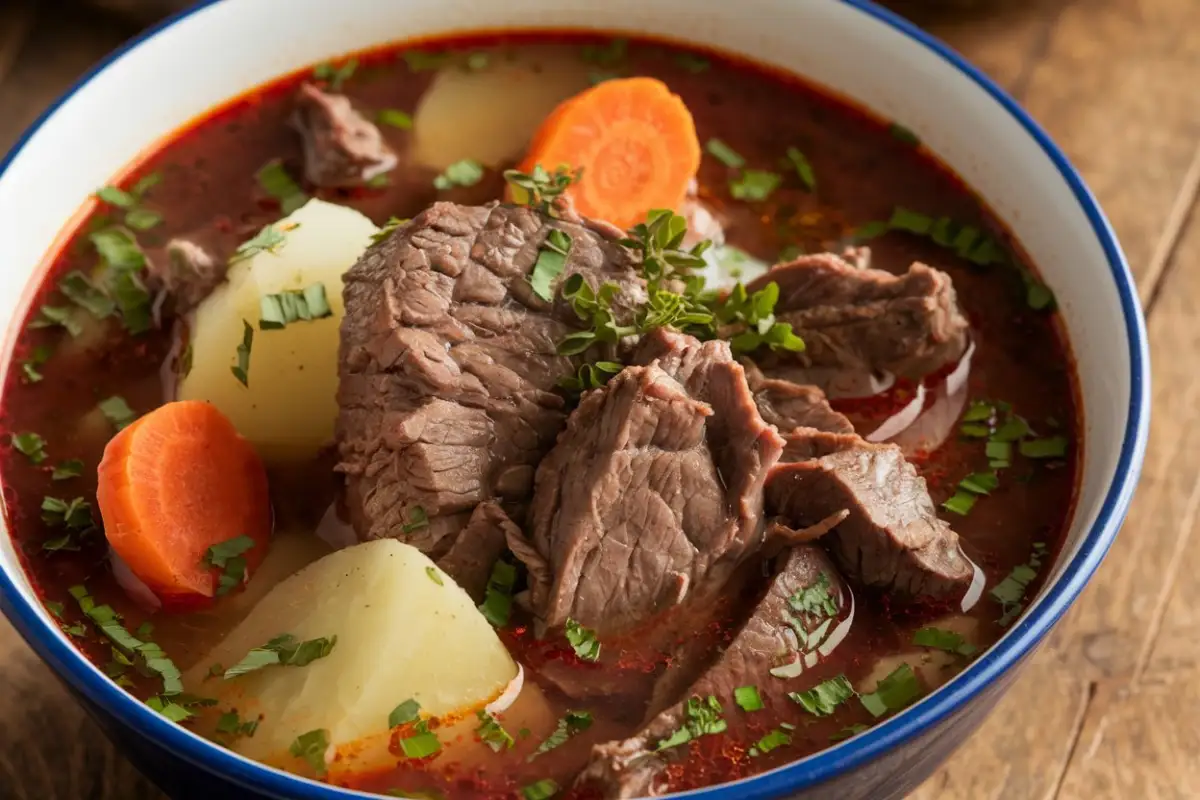Have you ever taken a sip of Flavor Beef Soup and felt like something was missing? Maybe the broth wasn’t rich enough, or the seasonings didn’t quite come together. Flavor Beef Soup is supposed to be a comforting dish, but without the right techniques, it can turn out bland. Don’t worry—I’ve got you covered! Let’s dive into the art (yes, art!) of making Flavor Beef Soup taste absolutely incredible.
Why Flavor Matters in Beef Soup
First things first: why is it so important to get the flavor right in Flavor Beef Soup? This dish isn’t just about filling your stomach—it’s about creating a warm, hearty experience. When made correctly, Flavor Beef Soup is a bowl of pure comfort, with deep, savory broth and perfectly tender beef. But if the flavors aren’t balanced, the experience falls flat.
Common Challenges in Beef Soup Flavoring
Ever wondered why your Flavor Beef Soup sometimes turns out too bland or overpowering? One of the biggest challenges is building depth in flavor. If the broth is weak, the entire dish lacks richness. On the other hand, adding too much of one seasoning can throw the balance off completely. The key to a delicious Flavor Beef Soup is layering ingredients carefully to achieve the perfect harmony of taste.
Lack of Depth in Taste
You’ve simmered your soup for hours, but it still tastes watery. Sound familiar? This usually happens when the base isn’t strong enough. A weak broth equals weak flavor—simple as that. It’s like trying to build a house on sand.
Overpowering or Bland Flavors
Sometimes, when faced with blandness, we try to “fix” it by adding too much of one ingredient—whether it’s salt, pepper, or even spices. However, this often backfires. As a result, the soup can end up tasting like saltwater or as if a spice rack exploded into it. Therefore, balancing flavors is absolutely key. On the other hand, overcompensating with one element can make the situation even worse. Instead, it’s important to approach adjustments gradually and thoughtfully to achieve the perfect harmony of flavors.
Balancing Ingredients to Enhance Beef Soup Flavor
Speaking of balance, ever added too many spices, only to find they don’t play nice together? It’s like inviting your favorite friends to a party but forgetting they don’t get along. Ingredients need harmony, and understanding which ones complement each other makes all the difference.
Choosing the Right Stock for Rich Flavor
Your soup’s base is everything! If you want the best Flavor Beef Soup, you need to start with a rich and flavorful broth. A homemade beef stock, simmered for hours with beef bones, onions, and herbs, will give your Flavor Beef Soup the deep umami taste that makes it unforgettable.
The Importance of Rich and Balanced Flavors in Beef Soup
If you’re using plain water as your base, we need to talk. Beef stock—or better yet, homemade beef stock—is where the magic begins. It’s packed with umami, that savory flavor that makes you want to go back for seconds. The trick? Simmer beef bones, onions, carrots, and celery for hours to extract every bit of goodness. No time for homemade? A high-quality store-bought stock can work too. Just avoid anything too salty or artificial.
Alternative Broths and Their Impact on Flavor
Not a fan of traditional beef stock? You’re not alone. Some people swear by chicken stock for its lighter flavor, while others love veggie-based broths. Each option brings a unique twist to the table, so don’t be afraid to experiment. Just remember: the base sets the tone, so choose wisely.
Building Layers of Flavor with Aromatics
If the base is your soup’s foundation, aromatics are the walls, windows, and doors. They create depth, turning a simple broth into something extraordinary.
Sautéing Onions, Garlic, and Celery
Here’s a game-changer: sauté your aromatics before adding them to the soup. Onions, garlic, and celery develop a natural sweetness when caramelized, adding a subtle richness to your broth. Think of it as seasoning your pan before the soup even starts.
Adding Acidity to Brighten and Balance Beef Soup Flavor
Timing is everything. Add fresh herbs like thyme and parsley too early, and they’ll lose their punch. Throw in spices like bay leaves at the end, and they won’t have time to infuse. The secret? Layer them throughout the cooking process. Start with sturdier herbs and spices, then finish with delicate ones for a burst of freshness.
Enhancing Taste with Meat Selection and Preparation

When it comes to beef soup, the meat isn’t just an ingredient—it’s the star of the show. Choosing the right cut and preparing it properly can make or break the dish. Let’s dig in!
Choosing Cuts with Rich Marbling
Not all beef cuts are created equal. For soups, you want cuts with a good amount of marbling—those white streaks of fat running through the meat. Why? Fat equals flavor! Chuck roast, short ribs, or even oxtail are excellent choices because they break down beautifully during the cooking process, enriching the broth with their natural juices. Avoid lean cuts like sirloin; they can turn dry and chewy when simmered.
Pre-Browning Meat for a Deeper Flavor Profile
Want to know the secret to a rich, hearty soup? It’s browning the meat first. When you sear beef over high heat, it caramelizes the natural sugars and creates a depth of flavor that raw meat simply can’t achieve. Think of it as building a flavor foundation. A quick tip: don’t overcrowd the pan! Browning works best in small batches.
Vegetables That Naturally Flavor Beef Soup
Vegetables aren’t just the supporting cast—they’re the secret to adding complexity and balance to your beef soup.
Root Vegetables That Enhance Soup Flavor
Carrots, parsnips, and turnips are soup MVPs. They not only add sweetness but also complement the savory flavors of the beef. Dice them into even pieces so they cook uniformly, and let them simmer slowly to release their natural sugars. The result? A soup that tastes like it’s been kissed by nature.
Timing Vegetables for Optimal Soup Flavor
Nobody likes mushy vegetables. Timing is everything! Hard veggies like potatoes and carrots should go in early, while delicate ones like green beans or spinach are best added near the end of cooking. This keeps them vibrant and fresh, adding both flavor and visual appeal.
Secret Ingredients to Intensify Beef Soup Flavor
Umami Boosters: Add a splash of soy sauce, miso, or fish sauce for a savory punch.
Acid Balancers: A hint of vinegar or a splash of wine brightens the soup and balances the richness.
For more tips on enhancing meat dishes, check out our Smoked Meatloaf Guide.
Umami Enhancers: Soy Sauce, Miso, or Fish Sauce
If your soup tastes flat, it’s probably missing umami, that savory, mouthwatering flavor that makes you crave another bite. A splash of soy sauce, a teaspoon of miso paste, or even a few drops of fish sauce can work wonders. These ingredients blend seamlessly into the broth, amplifying its depth without overpowering it.
Acidic Balancers: Lemon Juice, Vinegar, or Wine
Ever felt like your soup was missing a spark? That’s where acidity comes in. A squeeze of lemon, a splash of vinegar, or a glug of white or red wine adds brightness and cuts through the richness of the beef. Think of it as the yin to the soup’s yang—balancing richness with freshness.
Common Mistakes When Trying to Flavor Beef Soup
Even with the best ingredients, mistakes can happen. Let’s troubleshoot a few common ones so you can avoid them like a pro.
Overcooking Ingredients
Simmering soup for hours is great for flavor, but it can also turn your meat and veggies into mush if you’re not careful. The key is low and slow cooking—keep it at a gentle simmer, not a rolling boil. And don’t forget to check your ingredients periodically!
Adding Salt Too Early
Salting your soup too early can be a disaster. As the liquid reduces, the salt becomes more concentrated, which can lead to an overly salty soup. Instead, season lightly at the start and adjust toward the end.
Fine-Tuning the Flavor of Beef Soup Before Serving
You’ve simmered your beef soup for hours, and it’s almost ready. Now comes the final—and arguably most important—step: fine-tuning the flavors. Think of this as the polishing touch that turns a good soup into an unforgettable one.
Seasoning Gradually for the Perfect Balance
Here’s a tip that separates seasoned cooks from beginners: never add all your salt, pepper, or spices at once. Instead, season gradually and taste as you go. This allows you to control the balance of flavors and avoid over-seasoning. Take a spoonful, let it cool for a moment, and then taste. Does it need more salt? A pinch of pepper? A dash of acidity? Adjust accordingly until every spoonful sings.
Skimming Fat to Improve the Taste of Beef Soup
Flavor Beef Soup, especially when made with fatty cuts, can end up with an oily surface. While some fat adds richness, too much can overwhelm the flavors. To fix this, use a spoon to skim off excess fat. Alternatively, you can refrigerate the soup once it’s cooked, allowing the fat to solidify on top for easy removal.
Creative Garnishes to Enhance Presentation and Taste

Enhance both the taste and presentation with:
- Fresh herbs like parsley or cilantro.
- A swirl of cream or olive oil.
- Crunchy croutons or grated cheese.
Explore additional garnishing ideas in this Vegetable Beef Soup Recipe, which showcases creative finishing touches.
Fresh Herbs, Cheese, and Croutons to Enhance Beef Soup Taste
A sprinkle of freshly chopped parsley, cilantro, or chives adds a pop of color and freshness. Want a bit of crunch? Add homemade croutons seasoned with garlic or herbs. For a luxurious touch, shave some Parmesan or Gruyère over the top. These small additions make a big impact.
Drizzles of Oil or Cream to Boost Beef Soup Flavor
A swirl of extra virgin olive oil or a dollop of sour cream can work wonders. These garnishes not only enhance flavor but also add a visual flourish that makes the dish more appealing.
Solutions to Salvage a Bland Soup
Even the best cooks have off days. If your soup tastes bland despite your best efforts, don’t panic. There are quick fixes to save the day.
Quick Fixes: Adding Concentrated Flavor Boosters
A bland soup can often be rescued with a few concentrated ingredients. Add a teaspoon of beef bouillon paste or a splash of soy sauce to intensify the savory notes. Tomato paste is another great option—it adds depth without overpowering the beefy flavor.
Using Spices and Heat to Improve Beef Soup Taste
Sometimes, a pinch of spice is all your soup needs. Red pepper flakes, smoked paprika, or even a touch of cayenne can add warmth and complexity. But remember: less is more. Start with a small amount and build up gradually.
Conclusion: Master the Art of Adding Flavor to Beef Soup
And there you have it—everything you need to know to create a beef soup that’s bursting with flavor. From choosing the perfect cut of meat and layering aromatics to fine-tuning the final dish and adding creative garnishes, every step plays a role in crafting a bowl that’s as satisfying as it is delicious.
Remember, soup-making is both an art and a science. It takes patience, practice, and a willingness to experiment. So, the next time you’re craving a comforting bowl of beef soup, you’ll have all the tools to make it unforgettable.

